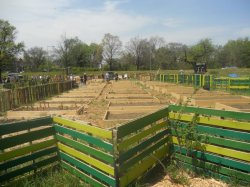 On a clear Sunday in March, Josh Singer and Sarah McLaughlin stood before a bowl-shaped, 2.7-acre lot in Washington, D.C.’s Park View neighborhood, wondering whether their vision for a community garden would ever really come to pass. The lot had been tied up in red tape for months, and no city agency even had record of the land. “I didn’t think we’d ever get permission to use it,” admits McLaughlin.
On a clear Sunday in March, Josh Singer and Sarah McLaughlin stood before a bowl-shaped, 2.7-acre lot in Washington, D.C.’s Park View neighborhood, wondering whether their vision for a community garden would ever really come to pass. The lot had been tied up in red tape for months, and no city agency even had record of the land. “I didn’t think we’d ever get permission to use it,” admits McLaughlin.
The organizers also needed to raise $700 for a water meter, and though they had been canvassing, flyering, and blogging for some time, they didn’t know if anyone would claim the garden beds they were planning, let alone volunteer to build them.
That day, more than 100 sets of hands showed up ready to dig, haul, and hammer. They built two dozen raised beds, a compost bin, and a fence made of wood pallets. The bloc of volunteers was so vast and their buy-in so fierce that soon the garden expanded from the initial planned 25 beds to 60. Soon, the area was studded with fruit trees, a berry garden, colorful hand-painted signs, and a public plot that can be collectively maintained and harvested.
Now, as it completes its first growing season, Wangari Gardens, named for the late Nobel laureate Wangari Maathai, is a good example of the kinds of roller coasters scrappy new community gardens often face — and the power of persistence.
It all started in late 2011 when Singer, a graduate student studying history at George Mason University, noticed a grassy park sitting vacant in his food desert neighborhood. He started to envision a community garden. When he realized he had a project on his hands, Singer brought in McLaughlin, a school garden instructor, to help.
In a city that aims to put natural spaces within walking distance of 100 percent of its residents [PDF], one would think that a community garden project would be seen as a priority. This hasn’t always been the case.
One by one, city government offices denied responsibility for this plot of land bordering a large hospital in northwest D.C.

Officials from the Embassy of Kenya, plot holders, and garden organizers gathered for a memorial planting in honor of Wangari Maathai in the fall of 2012.
“Everyone was giving us different answers. Department of Transportation was saying, ‘It’s Washington Hospital Center.’ Washington Hospital Center was saying, ‘It’s Department of Rec.’ Department of Rec was saying, ‘It’s National Parks,’” Singer recalls in a fundraising video about the garden (see below). He waded through geospatial data and pored over maps trying to figure out who oversaw the lot. Finally, an employee at the Office of the Surveyor took pity on Singer and found a tie to the District Department of Transportation. DDOT then worked with the nascent community organization to form an agreement, and — finally — Wangari Gardens had itself a dedicated space.
Next came the water question. Even after the city’s water agency granted Wangari a usage meter (an instrument usually reserved for construction sites), they still had to convey the water over a busy street to their cistern and dispense some 1,000 gallons each week to the thirsty plots. With summer temperatures in the triple digits, a kink in either part of this process would have spelled agricultural carnage.
A Franken-hose made from half a dozen industrial hoses, some duct tape, and a lot of prayer took care of the first problem. The second problem was solved when plot holder Judea Lawton wrangled the support of another government entity called the Summer Youth Employment Program. So every weekday for most of the summer, a local teen was paid to water and weed.
Soon the garden was helping area residents eat healthier on a budget. “It’s like a sin to be healthy,” says plot holder Antoinette Inge. “You have to pay for it.” Over the summer, Inge packed her parking space-sized bed with kale, spinach, arugula, and radishes.
Some also see the garden as a safe haven. “It’s hard to be a parent in this city. The yards are small, the freaky people are many,” says plot holder Nat Malkus, an education research analyst and father of three. “[Wangari] is a setting that we need.” It helps that Singer and McLaughlin “really have a heart to not just have the young hipsters and the young professionals involved in Wangari,” says Angela Strange, coordinator of a kids program in the area.
As winter approaches, the garden still faces challenges. Passing traffic wore down the first Franken-hose, there’s still a waiting list of 20 people, and one of the founders’ first visions, a wheelchair ramp, has yet to materialize. But in November, a fully funded Kickstarter campaign allowed them to expand their shed. And they have plans for a community compost drop-off and rain-catching structures. The youth program will also continue next summer, and there is a plan for a seed library.
Wangari Gardens might yet encounter a deal-breaking challenge. But the organizers’ approach keeps Lawton optimistic. “When you’re generous and you’re kind,” she says, “I think the whole universe works together for good.”
[protected-iframe id=”d68a7aafeb81db1cc6e195b030eccb3d-5104299-30178935″ info=”http://www.kickstarter.com/projects/172777392/wangari-gardens-fall-expanison/widget/video.html” width=”470″ height=”353″]


